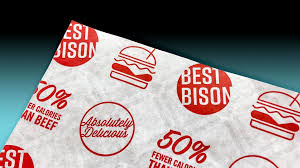Keeping fast food hot is important for taste and customer satisfaction. Many restaurants face the problem of food getting cold before reaching customers, which changes the quality of the food. One factor in keeping heat is using the right type of wrapping. Food items like burgers, fries, and tacos lose heat quickly when exposed to air. Wrapping in paper or placing in boxes can slow down heat loss. Materials with heat-retaining qualities, like wax-coated papers or layered cartons, create a barrier that keeps heat inside.
Why Do Fast Food Items Lose Heat Quickly?
Understanding why food cools down helps in selecting the right techniques. Fast food loses heat due to release to the air, moisture loss, and wrapping. Foods with water content material, like fries or fried chicken, lose heat quicker than tough items like sandwiches. When hot meals meet cooler air, heat is transferred from the food to the air.
Steam from food can carry heat away. Wrapping that traps steam can help keep food hot but must avoid making food wet. Some wrappers allow air to flow freely, which speeds cooling. Heat loss is faster when items are stacked in one paper because air moves around food and carries heat away.
How Do Wrapping Materials Affect Food Temperature?
The type of wrapping material affects how long food stays hot. Thin paper does little to prevent heat loss, while custom hot paper is designed to keep food hot for longer periods. Heat-resistant wrappers create a barrier between hot food and outside air. Some papers have wax coating that reflects heat back to food, while layered papers trap heat inside.
Fast food restaurants use custom paper that protects food and shows branding. Papers can include logos, patterns, or messages, making wrapping functional. Layered papers also control moisture, preventing wet food while keeping heat.
Small actions, like folding a burger wrap or sealing a taco wrapper, affect temperature. With proper wrapping, customers receive food that feels fresh and hot, like it was cooked recently. Using the right combination of paper and handling keeps food quality consistent and improves restaurant reputation.
Can Insulated Bags Help Deliver Hot Food Safely?
Insulated bags help keep food hot during delivery. These bags use materials that slow heat transfer, like foam or reflective lining. When food is placed inside, insulation prevents heat from leaving quickly, keeping food hot until reaching customers.
Restaurants can combine insulated bags with custom food paper or other wrappers to increase heat retention. For example, a wrapped burger in an insulated bag stays hot longer. Fries, tacos, and sandwiches all benefit from wrapping and insulation together.
Businesses can use custom paper wrapping to complement insulated bags. Proper insulation maintains food quality, and custom wrappers prevent spills. This method ensures food keeps temperature and arrives ready to eat.
What Role Does Steam Play in Keeping Food Hot?
Steam affects food temperature in two ways. Steam helps maintain heat but can make crisp food wet if trapped. wrapping needs to keep some steam inside but allow some to escape.
Custom hot Paper wraps manage steam balance. Air can escape through paper, preventing wet food, while heat is kept inside. For fried chicken or tacos, paper keeps inside temperature while controlling moisture. Restaurants that ignore steam management often deliver cold or wet food.
Businesses using custom wax paper can get wrappers that control steam. Paper keeps heat while reducing mess. wrapping that handles steam well ensures customers receive food at the right temperature and consistency.
How Do Food Stacking and Handling Affect Heat Retention?
Food arrangement affects heat. Items placed too close together can trap heat in some areas but lose heat in others. Sandwiches on top of fries can make fries wet, and stacked tacos may get soft.
Careful handling and arrangement in boxes helps food stay hot. Wrappers like food paper allow separation of items while keeping heat inside. Proper stacking prevents air from cooling food quickly.
Restaurants can use wax paper wrapping for stacking solutions. Wrappers and boxes keep food hot and neat. Handling food carefully improves customer experience. Small changes in stacking and arrangement increase freshness perception.
Are Heat-Retaining Papers Eco-Friendly?
Many heat-retaining papers, like Custom hot Paper, are made from materials that are recyclable or biodegradable. Wax coatings and layered papers can reduce environmental impact. Eco-friendly wrappers help restaurants provide hot food without creating waste.
Using sustainable wrappers can improve brand image. Customers prefer businesses that manage waste responsibly. The wax papers offers wrappers that maintain heat while being eco-friendly. Papers can include brand logos or messages without harming the environment.
Heat-retaining papers that are effective and eco-friendly ensure food reaches customers at the right temperature and support business sustainability.
How Can Businesses Choose Best Wrapping for Heat Retention?
Choosing wrapping involves balancing heat retention, food safety, and branding. Restaurants should consider food type, delivery distance, and customer expectations. Wax-coated paper is effective for sandwiches and burgers, while layered papers work for fries and tacos.
Startups can use wax papers to order custom fry paper and Custom hot Paper wrappers that fit their needs. Businesses can create wrapping that maintains heat, prevents spills, and shows brand. Consulting on paper type, thickness, and coating ensures food stays hot.
Businesses must consider both function and presentation. wrapping that maintains heat and neatness improves customer satisfaction. Wrappers and boxes become part of experience, encouraging repeat orders and loyalty.



